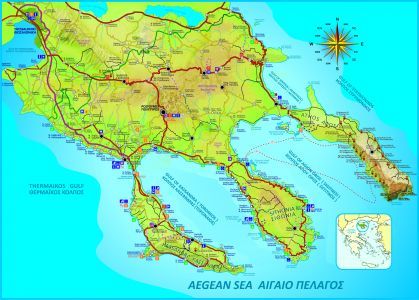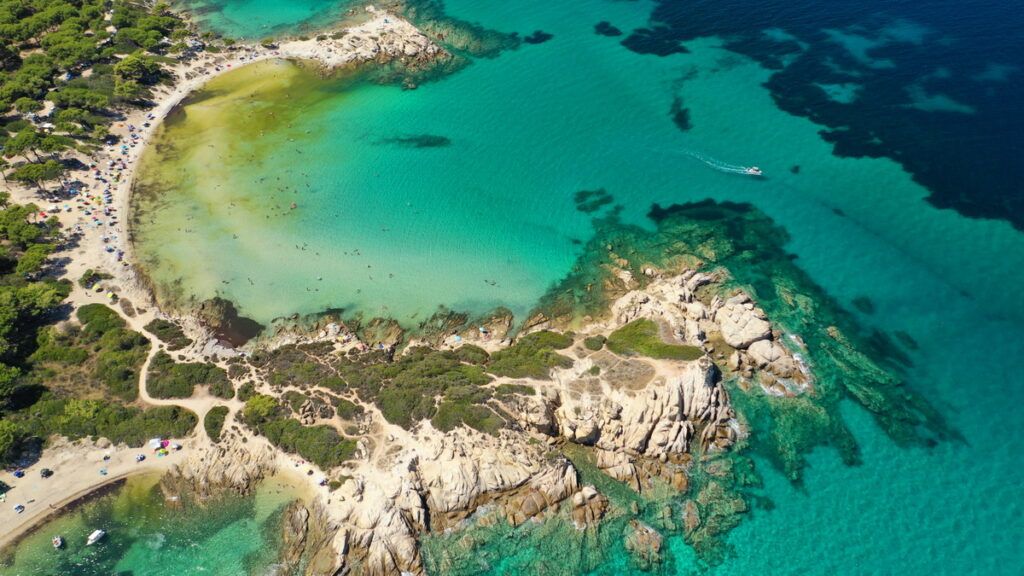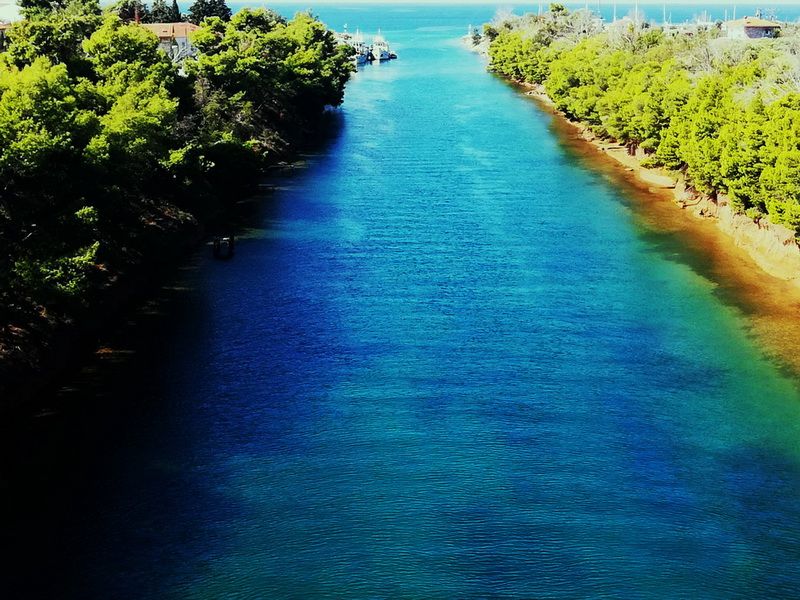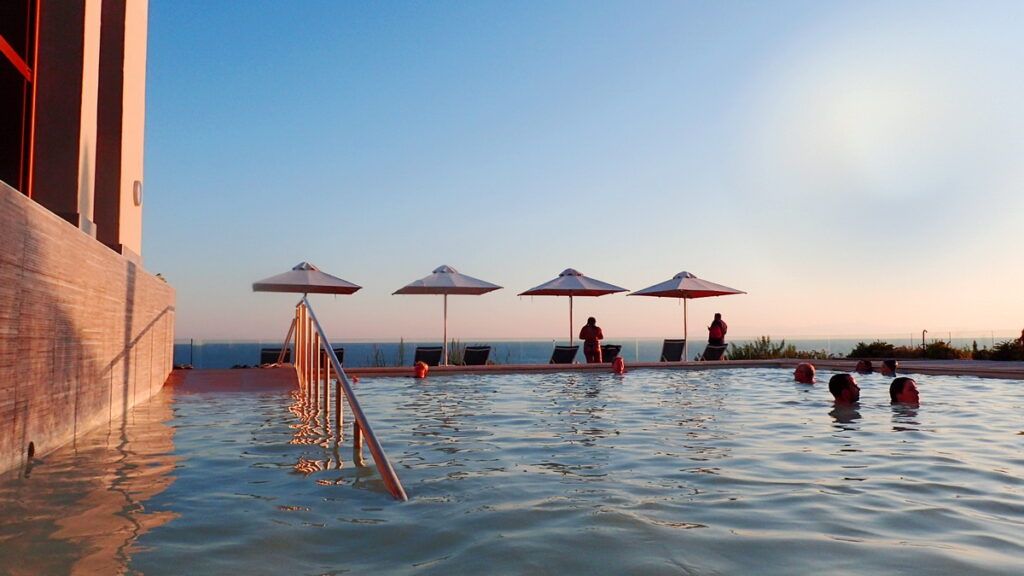Halkidiki is one of the most intriguing holiday destinations in Greece. By turns both wild and sophisticated, this lush green peninsula – sweet with the scent of pine – has 500 meters of coastline. Dazzling beaches are Halkidiki’s specialty, and there are many of them. But there’s also much more – whatever kind of holiday you fantasize about, Halkidiki delivers. We’d love to help you plan your trip to get the most out of your Halkidiki experience.
In this Halkidiki Guide, you’ll find everything you need to plan your visit, from practical details like how to get here quickly and easily from Thessaloniki and finding the ideal places to stay on any budget, to guides to the best beaches, cultural highlights, and rare experiences. Most of all we’ll help you enjoy Halkidiki like a local – sharing tips on the best classic seaside tavernas and enchanting villages, beaches worth hiking to, and good reasons to rent a boat.
Halkidiki Map

This peninsula of nearly 3000 square kilometers has a mountainous green interior, and three “legs.” The west of Halkidiki faces the Thermaic gulf – the “Thermaikos.” The first leg, to the west, is Kassandra. Sithonia is the middle leg, with the Gulf of Toroneos between them. The third leg of the Halkidiki peninsula, the easternmost leg, is Mt. Athos – Agios Oros. Between Sithonia and Mt. Athos is Agios Oros Bay, also called the Siggitikos Bay.
Continuing north along the eastern shores of Halkidiki, you come to the Ierissos Bay, by the town of the same name. Further north, by ancient Stagira, is the Strymmonian Gulf.
Halkidiki also has some small islands. Ammouliani is a popular destination off of the shores of northern Agios Oros, near Ouranoupoli. Off of eastern the shores of Sithonia, by enchanting Vourvourou, is Diaporos island, with the little islet of Aibelitsi right next to it. Off the western shore of Sithonis, in the Gulf of Toroni, are the islets of Pounda and Spalathronisia – between Porto Koufo to the south and Neos Marmaras to the north. The islet f Kelifos is across from Neos Marmaras.
An Introduction to Halkidiki:
Halkidiki – just an hour from Thessaloniki – is a famously lush, green peninsula that matches the Greek Islands for beauty and glamour. In the mountainous heart of the peninsula, rustic villages and historic towns express Halkidiki’s traditional character. The storied peninsula has been significant throughout all eras of Greece’s history, from the ancient world – Aristotle was born here – through early Christianity and Byzantium.
Of course, Halkidiki today is actually more famous worldwide for its dazzling beaches – and lots of them. Although attached to the mainland and quick and easy to reach from Thessaloniki, Halkidiki nonetheless delivers the complete Greek Island fantasy – the unspoiled wild beaches, the enchanting harbor towns, the classic seaside tavernas, and the glamorous summer nightlife.
Halkidiki has three “legs” – Kassandra to the west, Sithonia in the middle, and Agios Oros (Mt. Athos) to the east. Mt. Athos is an autonomous monastic state. This is a UNESCO world heritage site, and extraordinary cultural and spiritual treasure. While open only to male visitors on a pilgrimage by pre-arrangement, everyone can view the monasteries on their dramatic cliffs on boat tours.
It’s the beautiful beaches Kassandra and Sithonia that draw the most visitors, and there’s plenty of room for them along Halkidiki’s vast and unspoiled coastline. Halkidiki has a range of accommodations in every price range, from simple and economical rooms, to full-service organized campgrounds, to world-class five-star resorts and everything in between.
Each leg has its own character. Kassandra is the more sociable leg – full of excellent long sandy beaches and famous beach bars, where the holiday mood continues long after the stunningly romantic sunsets. Sithonia is the leg for Halkidiki connoisseurs – more laid-back, and full of beaches of legendary beauty – some wild and remote and until recently nearly word-of-mouth.
Lovers of nature and culture will also enjoy the main body of the Halkidiki peninsula, with its enchanting historic villages, an extraordinary cave, and archaeological sites like Ancient Olynthus and Stagira – the birthplace of Aristotle.
Halkidiki Travel Planning – Getting to Halkidiki
Few destinations in Greece that feel so exotic and remote are as easy to get to as Halkidiki. Nea Potidea, at the top of the Kassandra leg – closest to Thessaloniki – is just 40 minutes from Thessaloniki’s International Makedonia Airport (SKG). The town at the tip – Paliouri – is just an hour and 20 minutes. Even Kalamitsi, the most remote beach at the tip of Sithonia, is just a two hour drive from the airport.
Renting a car is definitely the most fun way to get around Halkidiki. You’ll have the freedom and flexibility to discover remote beaches and explore. The peninsula has a good network of paved roads, narrow in some places, hugging the coastline much of the way. The views along the way are amazing.
However, Halkidiki is also very easy to reach with public transportation. The KTEL regional buses service all Halkidiki destinations. There are several routes daily to many of the most popular spots, especially in the high season.
Here’s a complete and easy guide to getting to Halkidiki by bus, and to getting to the Halkidiki Bus station from Thessaloniki center and from Thessaloniki Makedonia Airport/SKG:
Halkidiki Beaches

The beaches of Halkidiki rank among the very best in Greece. Along the 500 kilometers of coastline, there are Halkidiki beaches of every description, from silky sands to windswept and wild coves. If you’re looking for a full-service luxury beach experience with cushy sun loungers and bespoke cocktails, you’ll have your pick. Or if you prefer to find your own private cove and bring a picnic, there are still plenty of hidden spots to discover.
Try these Halkidiki beach guides to get you started:
Halkidiki Historic Sights

Did you know that Aristotle was from Halkidiki? His birthplace, ancient Stagira, is now an archaeological site in one of the most beautiful archaeological locations in Greece. It’s so wild and green you’ll feel like you’re discovering it for yourself. Take time to stare out at the Strymonian gulf from above. Ancient Stagira is on the eastern shore of the Halkidiki Peninsula.
When you enter the Kassandra leg of Halkidiki, you’ll cross a canal far below. This is the Potidea canal, likely built by Cassander – the same Macedonian king who founded Thessaloniki and named it after his wife. Continuing down the leg to Nea Fokea (Fokes) along the east, you’ll come to a grand Byzantine Tower by the sea, built in 1407. You can’t miss it. But you’d easily miss an even more interesting site, directly across the road from the tower. Here is the sacred spring of St. Paul, who sought refuge from the pagans here, and baptized some of the first Christians of Europe from the waters that still flow from the spring. The Temple of Ammon Zeus, of the late 5th century BC, is directly next to the beach of the same name, with white sands and an emerald sea – it’s by Kallithea.
Potidea wasn’t the only canal of Halkidiki. At the top of the Sithonia leg, there was once another. The Persian king Xerxes, the one we know best perhaps from the Battle of Thermopylae (thanks in part to its adaption to the screen in “300”), built it in the early 5th century BC. It has filled up throughout the centuries since, but its traces can be seen. In Toroni, Sithonia, you’ll see the ruins of ancient Toroni, of the 8th century BC. These are at the tip of Sithonia, just above Porto Koufo.
Here’s a general overview of the main sights of Halkidiki:
Natural Wonders in Halkidiki

The beaches would be enough to satisfy anyone, but actually Halkidiki is a fantastic nature destination apart from the turquoise waters of the Aegean.
There’s a surprising alternative to the sea in the south of the Kassandra leg, Here, in Agia Pareskevi, you’ll find some premium thermal therapeutic springs. There’s a modern municipal spa facility, overlooking the Thermaic gulf. Those who want a luxury spa experience though may prefer a stay at the glamorous Miraggio Thermal Spa Resort., whose magnificent wellness center draws on the same mineral-rich, healing springs.
All this sea and sky in beautiful Halkidiki – but the beauty also continues under the earth. Petralona cave is a paradise of rock formations and glittering minerals – including “cave pearls.” In the adjacent museum, you can learn of the fascinating paleontological findings, including the “Petralona Skull” – belonging to one of our evolutionary ancestors.

